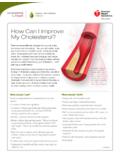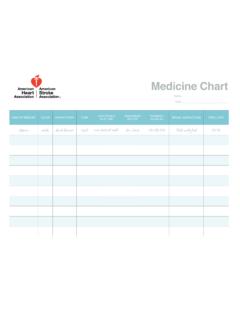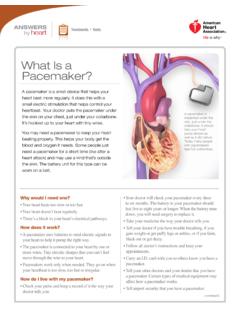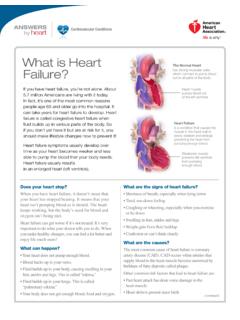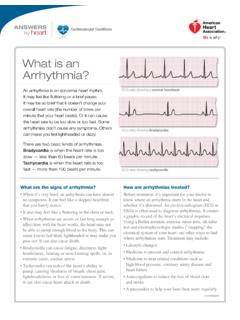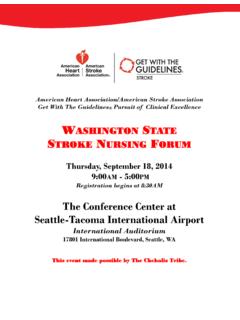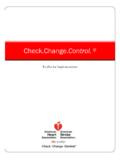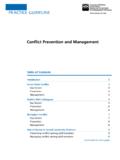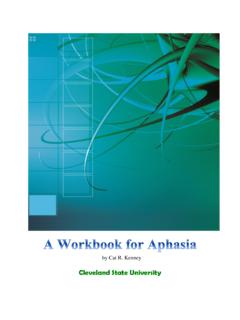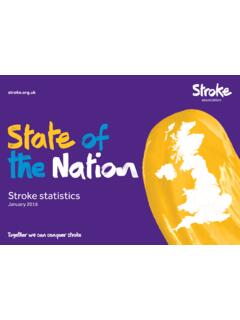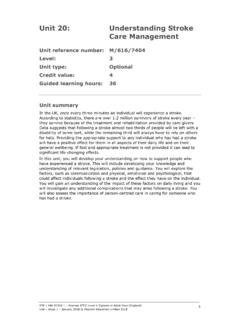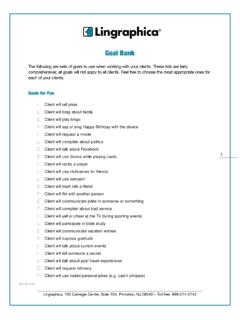Transcription of Acute Stroke Practice Guidelines for Inpatient Management ...
1 OHSU HEALTH CARE SYSTEM. Practice STANDARD. Acute Stroke Practice Guidelines for Inpatient Management of Ischemic Stroke and Transient Ischemic Attack (TIA), PS Last Reviewed Date: 5/5/2010. Statement of Standard OHSU Hospitals and Clinics have adopted these Practice Guidelines in order to delineate a consistent, evidence-based approach to treating the patient who presents with signs and symptoms consistent with Acute Stroke . Although these Guidelines assist in guiding care, responsibility to determine appropriate care for each individual remains with the provider themselves. Outcomes/goals Create a multi-disciplinary, evidence-based, approach to the Management of Acute Stroke patients.
2 Patient plan of care to take into consideration the entire continuum of care from emergency department through rehabilitation. Physician Determine the appropriate unit for admission. a. Recommended Admission Criteria for Neurosciences ICU. 1. Acute Stroke symptom onset of < 24 hours. 2. Post IV (intravenous) or IA (intra-arterial) thrombolytics or device thrombectomy. 3. Patients with hemispheric Stroke in whom impending mental status decline and loss of protective airway reflexes is of concern. 4. Patients with basilar thrombosis or tip of the basilar syndrome. 5. Patients with crescendo TIAs. 6. Patient requiring blood pressure augmentation for a documented area of hypoperfusion.
3 7. Patients requiring IV blood pressure or heart rate control. 8. Patients requiring continuous cardiac monitoring. 9. Patients requiring q 1-2 hour neurological evaluation depending on symptom fluctuation or if ongoing ischemia is suspected. 10. Patients with worsening neurological status. 11. Patients post interventional neuroradiology procedure. b. Recommended Criteria for Admission to 10K: 1. Acute Stroke symptom onset > 24 hours and not meeting above criteria. 2. Non-crescendo TIAs where workup not completed. c. Complete appropriate physician order set(s): NEU: Stroke /Rule Out Stroke /TIA Admission. Interventional Neuroradiology: Post Procedure Orders NEU: Stroke : Post Thrombolytic Therapy.
4 Utilize ICU: Sedation Analgesia Delirium order set if sedation and/or mechanical ventilation required for greater than 24 hours. HUC, Pharmacy, and Process physician orders according to OHSU policy. RN. RN Complete admission database and initiate nursing plan of care according to the appropriate OHSU Adult Inpatient Standards of Care: Adult Critical Care Standard of Care Adult Acute Care Inpatient Standard of Care Physician Evaluate for loss of airway protection and need for intubation. For all patients who present to the hospital within 12 hours of symptom onset, document whether they were considered for the following therapies: a. Intravenous thrombolysis for symptom onset within hours.
5 B. Intra-arterial thrombolysis for symptom onset within 6 hours. c. Device thrombectomy for symptom onset within 12 hours. If eligible for thrombolytic therapy treat blood pressure prior to tPA. administration if Systolic BP >185 OR Diastolic BP >110: Labetalol 10 20 mg IV over 1 2 min;. may repeat x 1 OR Nitropaste 1 2 inches OR Nicardipine infusion, 5. mg/hr, titrate up by mg/hr at 5-15 minute intervals, maximum dose 15. mg/hr. If blood pressure is not reduced and maintained at desired levels (systolic <185. and diastolic <110), do not administer rtPA. Physician, RN, and Maintain adequate oxygenation and ventilation. Avoid prophylactic or prolonged RT hyperventilation.
6 Neurocritical care For patients who have received thrombolytics: physician 1. No IV heparin, warfarin, or antiplatelet drugs during the infusion or for 24 hours post infusion. 2. Avoid nasogastric tubes, blood draws, or invasive lines/procedures for 24 hours post infusion, if possible. 3. No intramuscular injections. 4. Head CT or MRI at 24 hours post infusion. Blood pressure Management Guidelines for patients during and for the first 24hr after having received thrombolytics: 1. Goal systolic blood pressure <180 mmHg, diastolic pressure <105. 2. Systolic 180-230 OR Diastolic 105-120: Labetalol 10 mg IV given over 1-2 minutes; may repeat or double labetalol every 10-20 minutes to maximum dose of 300 mg or give initial labetalol dose, then start Nicardipine 5 mg/hour IV infusion as initial dose and titrate to desired effect by increasing rate by mg/hour every 5.
7 Minutes to maximum of 15 mg/hour or consider a labetalol drip at 2-8 mg/min. 3. Systolic >230 OR Diastolic 121-140: Labetalol 10 mg IV given over 1-2 minutes; may repeat or double labetalol every 10 minutes to maximum dose of 300 mg, or give initial labetalol dose, then start Nicardipine 5 mg/hour IV infusion as initial dose and titrate to desired effect by increasing rate by mg/hour every 5. minutes to maximum of 15 mg/hour or consider a labetalol drip at 2-8 mg/min. If blood pressure Is not controlled by labetalol or nicardipine, consider sodium nitroprusside. 4. Diastolic >140: Sodium nitroprusside mcg/kg/min IV infusion initial dose and titrate to desired blood pressure.
8 RN For patients who have received thrombolytics: 1. Check with Stroke Team Physician or Stroke Coordinator to identify whether thrombolytic dose has been completed (since the IV t-PA dose is weight-based, there may still be medication left in IV bottle after dose is completed). 2. Perform focused neuro checks based on patient condition & vital signs Q 30. min. for 6 hrs., then Q 1 hr. for 16 hrs., and then per ICU standard of care. 3. Avoid nasogastric tubes, blood draws, or invasive lines/procedures for 24 hrs. post infusion, if possible. 4. If the patient already has an invasive line upon arrival from another hospital ( , arterial or central), observe very carefully for bleeding at the site and apply pressure as needed.
9 5. Maintain IV's already in place (restart only if necessary). 6. No intramuscular injections. 7. Observe for changes in neurologic exam and any signs/symptoms of intracerebral hemorrhage and document accordingly. Report any of the following immediately to the in-house Neuroscience ICU Physician/Team (pager 17014) and to the neurology resident on call: neurologic deterioration, sudden marked changes in vital signs, changes in level of consciousness, nausea, vomiting, diaphoresis, new headache. 8. Observe for any signs of adverse drug reaction and document accordingly. Report any of the following to the neurologist on call: gingival oozing, ecchymosis, petechiae, abdominal and/or flank pain, hemoptysis, hematemesis, shortness of breath, rales, rhonchi, arrhythmias.
10 9. Assess IV/arterial puncture sites, urine, gums, skin, stool, emesis, etc. for bleeding. Report to neurologist if this occurs. 10. Monitor extremities for color, temperature, and sensation. Neurocritical care For patients who have received thrombolytics: physician in direct collaboration with the 1. If clinical suspicion of intracerebral hemorrhage ( , neurological Stroke Team deterioration, new headache, Acute hypertension, nausea or vomiting), Physician or Clinical discontinue t-PA infusion and notify Stroke Team immediately. Stroke Coordinator 2. Obtain STAT CT scan for any neurological deterioration. and ICU RN 3. STAT labs: INR, PTT, platelet count, fibrinogen, type & cross.

